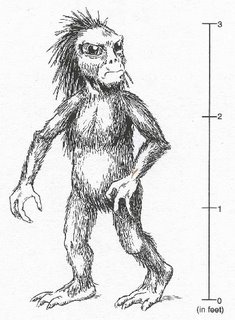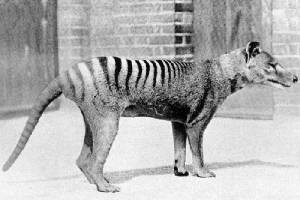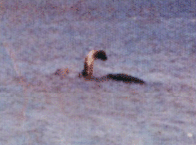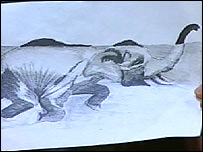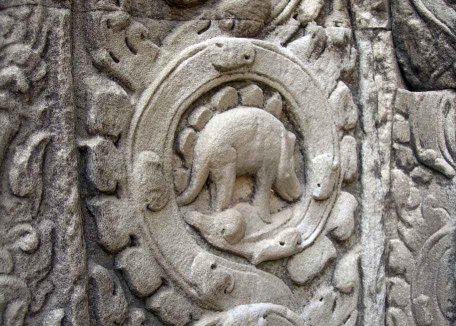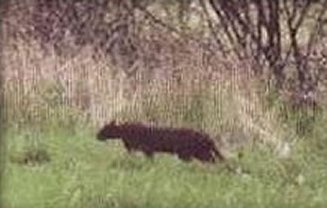|
It’s Not Just UFOs That Intrigue Us! While we’re all craning our necks and gazing skyward, seeking out those enigmatic UFOs, it is sometimes interesting to look down now and again and look into the bizarre creatures that are reported across the globe every day. Lumped into the category of cryptozoology, these strange animals defy science by remaining hidden and often eluding the gaze of man. Occasionally, though, stories emerge that remind us that there are still many, many mysteries right here on Earth. Here, we will cover just a few that have made the news recently. The Porcupine-Monkey In January, 2006, a story broke that American Navy SEALS videotaped a troupe of strange, ape-like creatures while on a secret mission in the Congo, sometime between 1997 and 2002. The creatures were described as being about 4.5-5 feet tall, grey in colouring and having long, porcupine-like quills running down their backs. The SEAL team said that the group they videotaped (which has never been released due to the covert nature of the operation – go figure!) were in the act of killing another animal and that in this excited state, the quills stood erect. The description of these odd, ill-tempered beasts resembles not only that of the legendary chupacabra of the Americas, but also of similar creatures known to the tribes of Madagascar, an animal they call the kalanoro. It seems that the animals are carnivorous and, indeed, the kalanoro is often blamed for the disappearances of children.
The kalanoro The Thylacine Officially, the thylacine, or Tasmanian tiger, a carnivorous marsupial, became extinct in 1936, when the last known specimen died in the Hobart Zoo on the island of Tasmania. Since ‘Benjamin’s’ death sixty years ago, though, sightings in the wild of thylacines have continuously occurred and not only on Tasmania. Most recently, on January 2nd, 2006, when a man driving in Colac, in the Australian state of Victoria, says he saw one run across the road in front of his car. He said the stripes on its rear, the distinctive, stiff tail and long, hind legs convinced him that “it was not a dog, feral cat or fox”. If the thylacine was found to still remain alive in Australasia, it would be one of the most important rediscoveries of modern times, on a par with the discovery of the coelacanth, the primitive fish found alive off the African coast after believed to be extinct for 65 million years.
The Thylacine “Champ” – The Monster of Lake Champlain While Scotland has Nessie, the beast said to rear its head from the murky waters of Loch Ness, other countries have their own lake monsters. Probably the most famous after our home-grown beast is Champ, the long-necked monster said to swim in Lake Champlain, a sixty-five mile long body of water along the New York/Vermont border. Champ is said to resemble Nessie, whom many cryptozoologists maintain is a type of plesiosaur, a marine reptile from the time of the dinosaurs, with a long neck, coils or humps and a length that varies from ten to almost two hundred feet. The latest sighting made headline news in the States on February 22nd, 2006, when a pair of Vermont fishermen videotaped something strange lurking in the water close to their boat. FBI forensic analysts have said the video is authentic, but of what it depicts, they cannot say.
A still from the February, 2006 video of Champ The most famous photograph of Champ was taken in 1977 by Sandra Mansi. It appears to show a long-necked creature in the water, but some have said it could be anything from a log to a whale’s fluke.
Sandra Mansi’s famous photo of Champ Speaking of debunking famous myths, recently a palaeontologist from Glasgow University explained away the Loch Ness Monster as being nothing more than an elephant swimming in the loch. Neil Clarke spent two years researching Scotland’s famous cryptoid and came to his conclusion after discovering that circuses often used the new road by the loch in the 1930s (when the modern wave of sightings began). He said that the animals of the big top would be allowed to take a dip in the cool waters and an elephant swimming partly submerged could easily be mistaken for Nessie!
An elephantine Nessie? Stegosaurs in Cambodia? The magnificent temples of Angkor Wat are one of the wonders of the ancient world. They marked the height of the Khmer Empire between the 8th and 14th centuries and draw tourists from all over the world. In February, the temple of Ta Prohm raised the eyebrows of cryptozoologists, when a photograph that appeared to show a carving of a stegosaurus appeared on the internet.
A Cambodian Stegosaurus? The carving is genuine. It is really there. But does it depict a dinosaur, an animal supposedly extinct for at least 65 million years? Stegosaurs were herbivorous dinosaurs that had two rows of bony plates that ran along their backs, just as shown in the carving, but what was one doing in Cambodia hundreds of years ago. The answer may be more close to home than you might think. Some people have suggested that what is actually depicted on the temple wall is a rhinoceros, that lived in the area in historic times, and that the ‘plates’ are actually representations of a leafy background. Others have also posited that the carving is a modern hoax, put there by artistic pranksters for the enjoyment of tourists. And, of course, some say that it is a dinosaur and proves that the history of our planet is all-to-cock and that dinosaurs and man shared the globe until fairly recently. Alien Big Cats The British countryside is famous for its cows and sheep grazing in green fields bordered by hedgerows and dry-stone walls. Its mammalian wildlife ranges from tiny shrews up to the Red deer, while our largest carnivore is the badger. Or is it? Since the 1960s, reports of large, cat-like animals have come from all over the country, the most famous being the Surrey Puma. In the 1980s, the so-called Beast of Bodmin ripped apart sheep in Cornwall. Things got so bad for farmers that the armed forces were called in to find the predator. Needless to say, they didn’t catch it. The reports carried on, with sightings and photographs coming from city suburbs to the wilds of Scotland. They became so numerous that a new term entered the lexicon: Alien Big Cats. By ‘alien’ we are referring to the fact that these felines are not native to the British Isles, rather than coming from another planet.
The Beast of Bodmin? The cause of this invasion was put down to the Dangerous Animals Act of 1976, which prevented the public from owning exotic animals ranging from ostriches to big cats to crocodiles without obtaining a special license. What this doesn’t explain is the sightings pre-1976 and also why we aren’t getting reports of wild ostriches and crocodiles by British picnickers! The release of alien creatures in the UK is not without precedent, however, as wallabies now thrive in Derbyshire, descendants of a group that escaped from a private zoo in the 1930s. The South American rodent, the coypu, also thrives in the wild in East Anglia, after being introduced in the 1920s. Luckily, nobody has been seriously injured by the alien big cats, although there are reports of people being attacked and terrified by these predators. For the most part, though, they appear to shun human contact. Sightings still occur and in February, 2006, casts were made of paw prints found in Scotland. Wildlife experts confirmed that the print was made by a big cat, possibly a black leopard. © Steve Johnson - 2006 (Originally published in Issue 3 of UFOData Report) |
